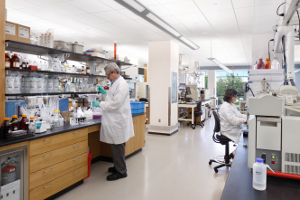LC-MS/MS - Liquid Chromatography Mass Spectrometry
Contacts:
Sarah MayEnvironmental Laboratory Supervisor
(319) 335-4237
sarah-may@uiowa.edu
Dr. John Vargo
Environmental Lab Scientist
(319) 335-4500
john-vargo@uiowa.edu
Liquid chromatography-tandem mass spectrometry (LC/MS/MS) is increasingly being used for the determination of semi-volatile organic chemicals at very low levels (typically sub-part per billion). This technique is highly specific for the chemicals of interest that are being tested. The Hygienic Laboratory has considerable experience and expertise in testing samples for organic contaminants using high performance liquid chromatography coupled with mass spectrometric detection.
Systems that are available for testing include an AB Sciex 5500 tandem quadrupole mass spectrometer, two AB Sciex 4000 tandem quadrupole systems, Micromass Quattro tandem quadrupole system, Termo LTQ Velos Pro ion trap system, and a Thermo Finnigan LTQ ion trap. Various high performance liquid chromatography systems are available to team with the mass spectrometry systems.
Our lab is qualified to perform many EPA drinking water methods that utilize LC/MS/MS such as EPA 535 (ESA/OXA degradates of chloracetanilide herbicides), EPA 536 (atrazine and dealkylated metabolites), EPA 537 (perfluorinated chemicals), and EPA 539 (hormones and steroids).
In addition, we frequently develop testing procedures to satisfy client testing needs. We have developed tests for emerging contaminants such as pharmaceuticals, antibiotics, and various human-indicating chemicals such as caffeine. We have developed methods to screen for fungicides and neonicotinoid insecticides at sub-part per billion levels in water. Our experienced staff can develop a customized testing procedure for chemicals of interest to you.
We are capable of testing a wide variety of matrices for chemical contaminants: drinking water, bottled water, groundwater, wastewater, soil, surface wipe samples, pesticide formulations, pesticide spray drift on soil or vegetation, food, and others.
Last updated May 22, 2017



